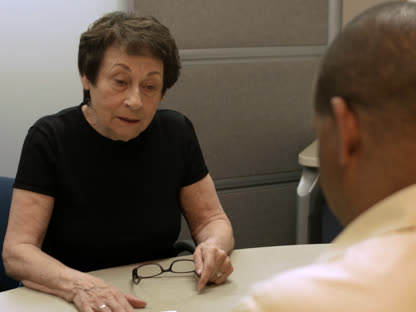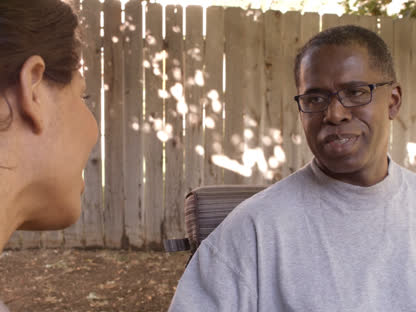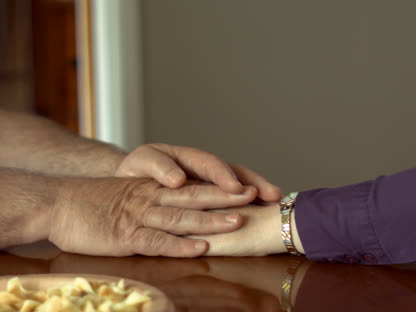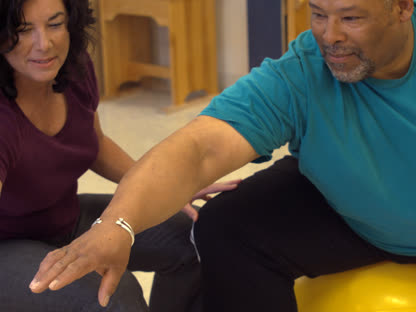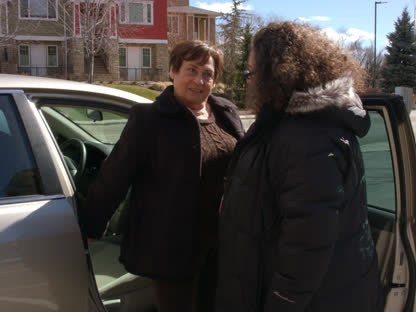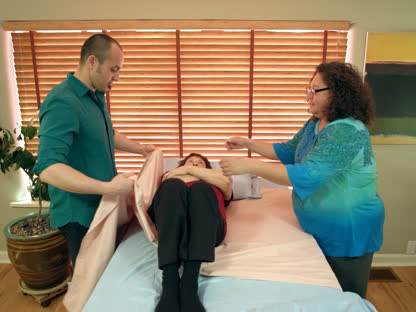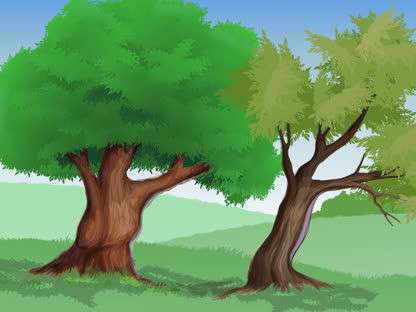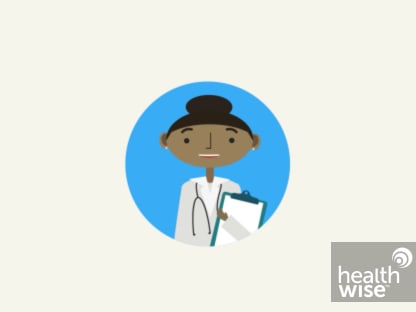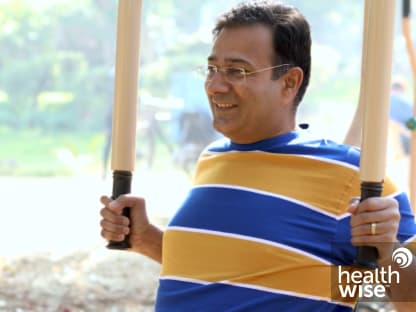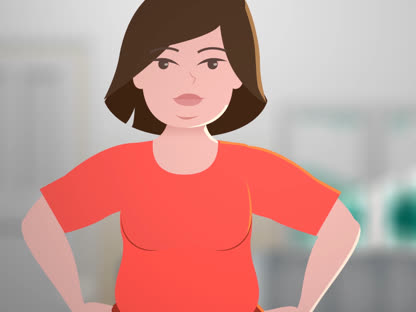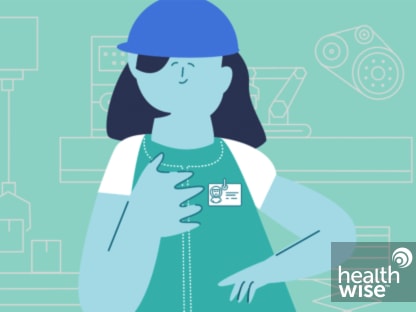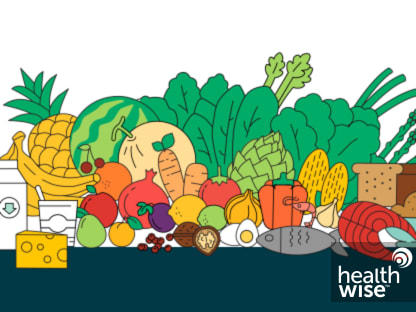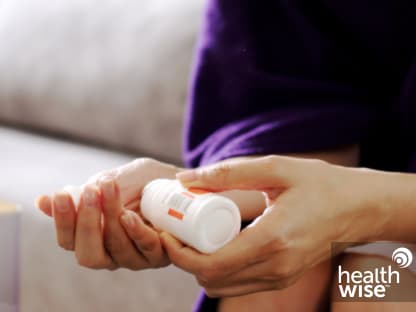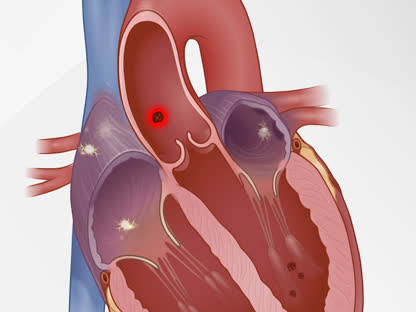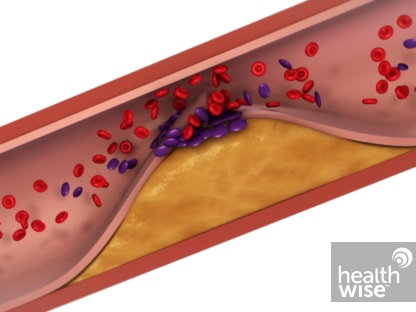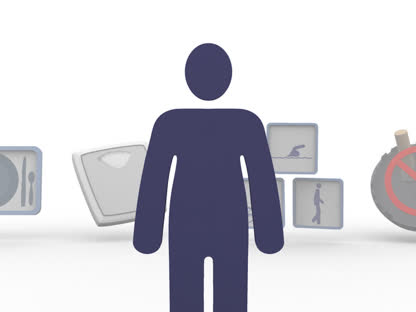Stroke Rehabilitation
How does stroke rehabilitation (rehab) help you get better after a stroke?
The best way to get better after a stroke is to start stroke rehabilitation (rehab). The goal of stroke rehab is to help you recover, prevent problems, and help you get back as much independence as possible by improving how you move, think, and feel.
Stroke rehab can help you to:
- Do as well as you can and be as independent as possible.
- Learn to live with the changes to your brain and body caused by the stroke.
- Adjust to living within your home, family, and community.
- Help prevent problems like falls or a blood clot in a vein (deep vein thrombosis).
In stroke rehab, a team of health professionals works with you to regain skills you lost as the result of a stroke. Your rehab will be based on how the stroke affected you. It also is based on your general health and your ability to participate.
- Rehab starts with helping you resume daily activities. This includes eating, bathing, and dressing.
- You may learn how to use assistive devices or orthotics. These are tools that help you hold objects, open and close things, transfer weight while shifting positions, or walk. These tools may be hard to get used to. But they help you return to your daily life and everyday tasks.
A key part of rehab is taking steps to prevent a future stroke. To stay in good health, you may need to take medicines and make some lifestyle changes. Work with your rehab team to decide what type of exercise, diet, or other lifestyle choices are best for you.
Who is on a stroke rehab team?
You and your family, loved ones, and caregivers are the most important part of the stroke rehab team. A team of health professionals will work with you and your caregivers to help you recover from a stroke. A rehab team may include doctors and nurses who specialize in stroke rehab. It may also include:
- A physical therapist.
- An occupational therapist.
- A speech-language pathologist.
- A recreational therapist.
- A psychologist or counselor.
- Other health professionals, such as a dietitian and a vocational counselor.
A social worker or case manager may help you and your caregivers arrange for the help and equipment you may need at home.
What kinds of problems can people have after a stroke?
The problems you have after a stroke depend on what part of your brain was affected and how much damage the stroke caused. They may include problems with:
- Movement and senses. You may have trouble walking, grasping objects, or doing other tasks. Other symptoms may include joint pain or muscle stiffness or spasms. You may not be able to feel when something touches an affected body part. You may feel very tired.
- Speech and language. Your ability to speak, read, or write may be affected. Also, you may not be able to understand what someone else is saying.
- Memory and thinking. You may not be able to think clearly. You may have trouble focusing or remembering.
- Perception. It may be hard to do things like judge distance, size, position, and rate of movement.
- Emotions. It's common to feel fearful, anxious, angry, sad, or frustrated. Grief is also common.
How long does rehab take?
How long you will be in a stroke rehab program depends on what kind of help you need. Rehab starts while you are still in the hospital. After you leave the hospital, you may continue treatment at a rehab center or at home.
You may recover the most in the first few weeks or months after your stroke. But you can keep getting better for years. It just may happen more slowly. And it may take a lot of time and hard work. Don't give up hope.
Health Tools
Health Tools help you make wise health decisions or take action to improve your health.
What to Expect After a Stroke
The problems you have after a stroke depend on what part of your brain was affected and how much damage the stroke caused. They may include problems with:
- Movement and senses. Effects may include:
- Weakness on one side of the body. This may cause trouble walking, grasping objects, or doing other tasks. The side of the body that is affected is opposite from the side of the brain that was damaged by the stroke.
- Feeling very tired.
- Joint pain and rigidity. A person with a very weak arm or leg may have pain caused by a tight or locked-up joint.
- Muscle stiffness or spasms (spasticity).
- Problems with your sense of touch or your ability to feel hot and cold. This may lead to an injury, such as a burn.
- Problems judging the position of parts of your body. You may not be aware of one side of the body.
- Pain, numbness, or tingling in your limbs.
- Trouble with starting and coordinating body movements (apraxia).
- Problems with swallowing and eating (dysphagia).
- Urinary or bowel problems. You may have trouble holding your urine (urinary incontinence). Or you may have trouble emptying your bladder (urinary retention). Or you may have constipation or problems controlling bowel movements.
- Problems seeing in some or all of the normal areas of vision.
- Speech and language.Speech and language problems (such as aphasia) may occur when a stroke damages the area of the brain responsible for language. Some people who have aphasia may not be able to understand written or spoken language, read or write, or express their own thoughts. A speech problem called apraxia can happen if a stroke affects the muscles used for speech.
- Memory and thinking.A stroke may damage parts of your brain that control awareness, learning, and memory. You may have trouble:
- Focusing or remembering.
- Making plans, learning new activities, or doing other complex tasks.
- Acknowledging the physical impairments caused by your stroke.
- Perception.
- You may have trouble judging distance, size, position, rate of movement, form, and how parts relate to the whole.
- Some people have trouble recognizing body parts on the affected side. This is especially true for people who don't have feeling in the affected arm or leg.
- Emotions. It's common to feel:
- Fearful, anxious, angry, sad, or frustrated. Grief is also common after a stroke.
- Depressed. Depression is a serious condition that requires treatment.
Learn more
Stroke Rehab and Your Recovery
Stroke rehabilitation (rehab) is training and therapy to help you recover and prevent problems after a stroke. The team may help you learn new ways to do daily activities. The focus of rehab will depend on how the stroke has affected your ability to do the things you want and need to do.
Rehab may begin in the hospital. It starts as soon as you are able. You will have a team of doctors, nurses, and therapists. The team can help you in many ways. For example, the team may help you learn new ways to do daily activities such as eating, bathing, or dressing. They can teach you to prevent problems like falls or burns. Some people need help to learn how to walk or talk again. If the stroke affected your memory, you will learn ways to improve it.
You may recover the most in the first few weeks or months after your stroke. But even with rehab, you may not be able to do all the things you could before the stroke. But you can continue to get better even after the first few months.
After the hospital, you may go to a rehab facility or a nursing home for a while. Or you may go home. Wherever you go, keep working on your rehab and do a little every day.
It's going to be important for you to get the support you need. Your friends and family can help you. Involve them in your treatment. They can be part of your rehab team. Talk to others who have had a stroke, and find out how they handled ups and downs.
Learn more
Watch
Concerns of the Caregiver
Taking care of someone who has had a stroke can be hard for many reasons. Some concerns may include:
- Being afraid that they will have another stroke or won't be able to accept or overcome disabilities.
- Worrying that you're not prepared to care for someone who's just had a stroke. Or you may work or have your own health concerns that make it hard to care for another person.
- Becoming depressed over losing the lifestyle that you used to enjoy.
- Worrying about the costs of rehab and a loss of income.
If you have concerns, the stroke rehab team can help. The team can:
- Provide training. Before the person returns home, the rehab team will train you or other friends or family to help with therapy. You may learn to help them get up from a fall, eat, dress, get to the bathroom, and do other activities.
- Help you find support. If you work or have your own health concerns that prevent you from being able to help, you may need in-home help. Or you may consider if a nursing home or assisted-living facility is an option. The rehab team can give you more information about local resources, such as in-home help. They may also be able to offer advice about insurance coverage.
- Provide counseling and emotional support. The rehab team can support you and help you adjust. They may suggest local support groups in your area.
Even if you can't provide physical help, your support is still key to their recovery.
Providing support to someone who had a stroke
Here are some ways to help.
- Realize that after a stroke, the person may be prone to strong emotional reactions. Remember that these are a result of the stroke. Try not to become too upset by them.
- Don't avoid someone who's had a stroke. Contact and support is very important to their recovery.
- Join a local support group. These groups provide a place where issues can be discussed in a supportive environment and an opportunity to meet others dealing with the same issues. Ask your doctor or the stroke rehab team about support groups in your area.
- Take care of yourself too. If you are a caregiver, you must stay healthy enough to help.
You are an important part of their recovery after a stroke.
- Give the person support and encouragement to participate in the decisions about their rehabilitation (rehab) program.
- Visit and talk with the person often.
- Participate in educational programs, and attend some of the rehab sessions.
- Help the person practice the skills they're learning.
- Work with the program staff to match the activities to what the person needs to do after returning home.
- Find out what the person can do independently and where help is needed. Avoid doing things for the person that they can do without help.
Learn more
Watch
Preventing Another Stroke
After you've had a stroke, you're at risk for having another one. But you can help reduce your risk. Things you can do include:
- Managing health problems that raise your risk. These include atrial fibrillation, diabetes, high blood pressure, and high cholesterol.
- Taking your medicines exactly as prescribed.
- Having a heart-healthy lifestyle.
- If you smoke, vape, or use other tobacco or nicotine products, try to quit. If you can’t quit, cut back as much as you can. Talk to your doctor if you need help quitting. Also avoid secondhand smoke and the aerosol mist from vaping.
- Stay at a weight that's healthy for you. Talk to your doctor if you need help losing weight.
- Be active. Ask your doctor what type and level of activity is safe for you.
- Eat heart-healthy foods. These include vegetables, fruits, nuts, beans, lean meat, poultry, fish, and whole grains. Limit sodium and sugar.
- Limit alcohol to 2 drinks a day for men and 1 drink a day for women.
- If you think you may have a problem with alcohol or drug use, talk to your doctor.
- Getting vaccinated against COVID-19, the flu, and pneumonia.
Learn more
Watch
Medicines for Stroke Prevention
Your doctor may prescribe medicines after you've had a stroke. These medicines can help lower your risk of another stroke. The types of medicines can depend on what type of stroke you had and what other health problems you have.
If you had an ischemic stroke, you will likely take medicines to prevent blood clots. Blood clots can cause an ischemic stroke. The types of medicines that prevent clotting are:
- Anticoagulant medicines. They prevent blood clots from forming. They also keep existing blood clots from getting bigger.
- Aspirin and other antiplatelet medicines. They keep platelets in the blood from sticking together.
Certain cholesterol medicines, including statins, can also lower the risk of another ischemic stroke.
Blood pressure medicines can lower the risk of another ischemic or hemorrhagic stroke.
Learn more
Watch
Related Information
Credits
Current as of: October 2, 2025
Author: Ignite Healthwise, LLC Staff
Clinical Review Board
All Ignite Healthwise, LLC education is reviewed by a team that includes physicians, nurses, advanced practitioners, registered dieticians, and other healthcare professionals.
Current as of: October 2, 2025
Author: Ignite Healthwise, LLC Staff
Clinical Review Board
All Ignite Healthwise, LLC education is reviewed by a team that includes physicians, nurses, advanced practitioners, registered dieticians, and other healthcare professionals.







